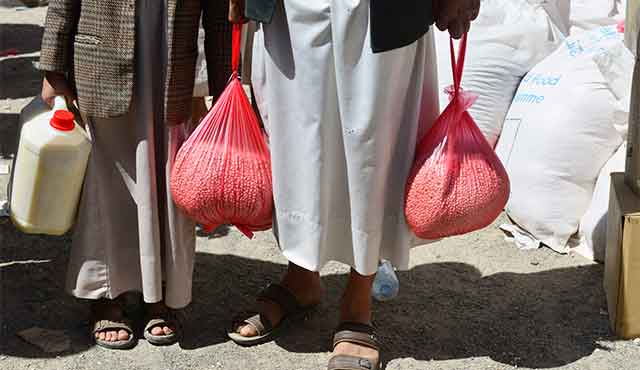- PAUL, Minn. (CNS) — With projections putting the planet’s population at 9 billion by 2050, the question of how to feed them is taking on ever-greater importance.
But at the “Faith, Food & the Environment” symposium Nov. 5-7 in St. Paul, held at the University of St. Thomas and sponsored by more than a dozen Catholic and agricultural organizations, some speakers suggested the question may need to be asked differently.
“It’s the wrong question,” said Fred Kirschenmann, a distinguished fellow at the Leopold Center of Iowa State University, giving people “a moral justification to continue doing more of what they’ve been doing.”
Kirschenmann said enough food is being grown today to feed 10 billion people, yet 1 billion people remain chronically hungry. “It’s a problem of poverty, it’s a problem of entitlement, it’s a problem of inequality,” he said. “It’s also a problem of waste.”
Estimates put the amount of waste at 40 percent of all food grown. “If you’re throwing away 40 percent of what is produced, is it optimal to produce 20 percent more?” asked Jesuit Father Michael Czerny, chief of staff to Ghanaian Cardinal Peter Turkson, head of the Pontifical Institute for Peace and Justice, one of the symposium’s sponsors.
The waste rate doesn’t come from people sliding uneaten food from their plates into a wastebasket or garbage disposal. The major of that wasted food, he said, is left rotting in farmers’ fields because they know the buyers of their crops do not want any blemished merchandise.
Kirschenmann said a French supermarket chain addressed the problem by stocking blemished produce and selling it at 30 percent off the prices asked for their unblemished counterparts. The tactic was so successful, he added, “you know what the problem is now? Supply.”
Calvin DeWitt, a professor at the University of Wisconsin’s Nelson Institute for Environmental Studies, took a different perspective. He said the problem is not how much food is grown, but who grows the food.
Most people living in developing countries, he argued, are subsistence farmers, They often grow enough to feed their family and to sell some at a nearby market. Their way of life, and existence, is threatened by such variables as bad weather and war, turning a hardscrabble life into one that could result in uprooting themselves from their land and seek refuge in big cities, if not other countries.
Hauling freighters full of wheat and other staples across oceans is not going to solve the problem DeWitt said, it will require a concerted effort to reach those farmers and their plots in advances made in farming.
Those advances may include genetically modified organisms. Some nations have refused to allow them, and some consumers in developed countries reject them. But some GMO crops may benefit the farmer with more, and more healthful crops. How to apply faith principles for GMO use? “It’s an interesting question — which is my way of saying I don’t know,” said Christopher Thompson, academic dean of the St. Paul Seminary School of Divinity at the University of St. Thomas. “You have to be careful about wild experiments.”
But the planet’s ability to feed itself may be at stake, according to Kirschenmann. Early humans, he said, were not food producers but “food collectors,” hunting, killing and eating prey for their subsistence.
In the past 10,000 or so years, humans have engaged in a process of what Kirschenmann called “slash and burn” farming. This process accelerated in the last century or so through using water, petrochemicals and minerals to make the land more productive.
While it has resulted in increased yields, the planet runs the risk of exhausting its resources. The Ogallala aquifer under Nebraska, said the Rev. Clifford Canku, a Presbyterian minister, member of the Dakota Indians, and a retired professor of Dakota studies at North Dakota State University. The aquifer’s water reserves were built up over millions of years. But at the pace the water is now being used up, it will run dry in about 50 years, he predicted.
Thinning topsoil runs the same risk. However, National Farmers Union president Roger Johnson, said the planting of “cover crops” after the harvest of a cash crop can restore the soil’s health, cutting pesticide use by 70 percent, and increasing rainfall retention. The soil under cash crops has been degraded to the point where it can absorb about only a half-inch of rainfall, he said. But after a few cycles of planting cover crops, the same soil can retain eight inches of rain.
That doesn’t take into account the old agrarian practice of letting land lay fallow through crop rotation practices to keep it strong. Kirschenmann said that, even when farmers ignore these practices, “nature abhors the density of any species. … If one method fails, she will try another.”
Another, and less comfortable way of looking at the question is by asking how many people the planet can sustain. Kirschenmann said, “We have to look at what the carrying capacity of the human species is,” he said. “I haven’t heard anyone say, ‘Oh, 9 billion or 10 billion people is all right,” adding he knows that ethicists and theologians have not wanted to deal with this issue.
Kirschenmann himself said he did not know what a sustainable number might be, tossing about the numbers 5 billion and 3 billion. But neither he nor anyone else at the symposium suggested how the planet might get down to a lower number.

